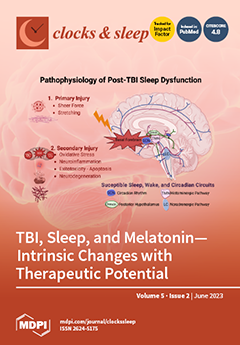The sleep–wake cycle is a highly regulated behavior in which a circadian clock times sleep and waking, whereas a homeostatic process controls sleep need. Both the clock and the sleep homeostat interact, but to what extent they influence each other is not understood.
[...] Read more.
The sleep–wake cycle is a highly regulated behavior in which a circadian clock times sleep and waking, whereas a homeostatic process controls sleep need. Both the clock and the sleep homeostat interact, but to what extent they influence each other is not understood. There is evidence that clock genes, in particular
Period2 (
Per2), might be implicated in the sleep homeostatic process. Sleep regulation depends also on the proper functioning of neurons and astroglial cells, two cell-types in the brain that are metabolically dependent on each other. In order to investigate clock-driven contributions to sleep regulation we non-invasively measured sleep of mice that lack the
Per2 gene either in astroglia, neurons, or all body cells. We observed that mice lacking
Per2 in all body cells (
Per2Brdm and T
Per2 animals) display earlier onset of sleep after sleep deprivation (SD), whereas neuronal and astroglial
Per2 knock-out animals (N
Per2 and G
Per2, respectively) were normal in that respect. It appears that systemic (whole body)
Per2 expression is important for physiological sleep architecture expressed by number and length of sleep bouts, whereas neuronal and astroglial
Per2 weakly impacts night-time sleep amount. Our results suggest that
Per2 contributes to the timing of the regulatory homeostatic sleep response by delaying sleep onset after SD and attenuating the early night rebound response.
Full article






